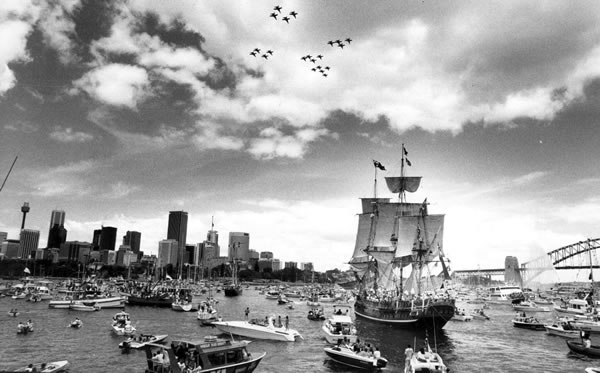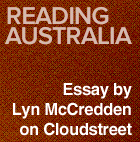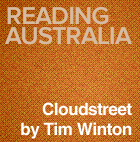AustLit
-
Cloudstreet (1991) by Tim Winton is a novel set in mid-20th century Perth.
This trail provides useful information and links to provide context and further reading.
– Part One discusses the novel's historical and geographical contexts.
– Part Two examines the novel's publishing and literary contexts.
– Part Three draws together some critical responses to Cloudstreet.
The trail finishes with links to interviews and reviews. Some of these critical works and other resources are available to read online. Click the hyperlinks in the citations below to be taken to the full text.
-
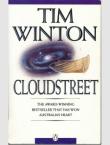 This image has been sourced from online.'From separate catastrophes two rural families flee to the city and find themselves sharing a great, breathing, shuddering joint called Cloudstreet, where they begin their lives again from scratch. For twenty years they roister and rankle, laugh and curse until the roof over their heads becomes a home for their hearts.' (Source: Publisher's website) (...more)See full AustLit entry
This image has been sourced from online.'From separate catastrophes two rural families flee to the city and find themselves sharing a great, breathing, shuddering joint called Cloudstreet, where they begin their lives again from scratch. For twenty years they roister and rankle, laugh and curse until the roof over their heads becomes a home for their hearts.' (Source: Publisher's website) (...more)See full AustLit entryExplore the AustLit record for Cloudstreet to discover more about the work and its place in Australia's literary landscape.
-
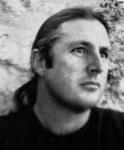 Photo credit: Leon BirdSee full AustLit entry
Photo credit: Leon BirdSee full AustLit entryBorn in Karrinyup, Western Australia, Tim Winton completed his high school education at Albany. Determined to be a writer from an early age, Winton subsequently studied creative writing at the West Australian Institute of Technology (now Curtin University). He became a professional writer and household name when, at the age of 21, he shared first prize in the 1981 Australian/Vogel National Literary Award for a manuscript that became An Open Swimmer (1982).
Explore the AustLit author entry for Tim Winton to discover other works and further details of his life, writing, and place in Australian literature.
-
See full AustLit entry
McCredden discusses national myth-making in Cloudstreet, arguing that '[t]he myths of Australian identity are not simply re-told in this novel, but are seen through the psychologies, actions and relationships of individual and intimately drawn characters [...] Australia as lucky and unlucky country? Land of working class battlers who fail, or heroes who make their own way? Cloudstreet seems to embrace the contradictions between these mythic elements without coming down heavily on those who spin myths, perhaps recognising that fiction writers are implicated in such makings.
(...more)Available online at Reading Australia.
-
Cloudstreet's Adaptations
Cloudstreet has been adapted into numerous forms. It was adapted first into a radio play for ABC Radio National in 1996 by Paige Gibbs. In 1998 it was adapted by Nick Enright and Justin Monjo into a stage play that toured internationally. In 2013 an opera version was in development, to be directed by opera and theatre director Gale Edwards and composed by George Palmer. A three-part miniseries screened on Showtime in 2011. You can see the trailer for the miniseries below.
//www.youtube.com/embed/xQMOa7vXRjY -
The 1940s were a time of war and its aftermath, while the 1950s were a time of optimism, but also of uncertainty. To find out what Australia was like in the 1940s and ‘50s (and other decades), look at the decade timeline on the My Place website.
-
Historical Perth
The National Film and Sound Archive offers some great examples of how government-produced films represented mid-20th century Perth. ‘Postcard from Perth’ (1954) shows pram racks on the back of old buses and conductors setting prams on the footpath for mothers (in the second half of the short film). You can watch the video below.
//www.youtube.com/embed/b2TaLGlj6ig -
Another Sunny Day in Western Australia
‘Another Sunny Day in Western Australia’ (1961) also gives a sense of the cultural changes that have taken place since the 1960s (note the promotion of suntans for toddlers, for instance).
//www.youtube.com/embed/9TcC83wEOcM?rel=0" frameborder="0 -
Cloudstreet’s Nedlands murderer is based on an actual murderer, Eric Edgar Cooke. Cooke murdered eight people in Perth from 1959 to 1963. He is also mentioned in Robert Drewe’s memoir The Shark Net and Craig Silvey’s novel Jasper Jones, which is set in the mid-1960s. Contemporary newspaper accounts are available via Trove; for example, see the Canberra Times article from 22 October 1963: 'Man in Perth Court on Triple Murder Charge.'
-
Other Australian books set in mid-20th century Perth include Elizabeth Jolley’s The Newspaper of Claremont Street (1981), Simone Lazaroo’s The World Waiting to be Made (1994) and Mudrooroo’s Doin Wildcat: A Novel Koori Script (1988).
-
It is helpful to consider the publishing and literary contexts in which Cloudstreet appeared. While the book is set in the middle of the twentieth century, it was published in 1991, at a time when questions about national identity, the past, and the future were particularly prominent.
-
Publishing Context
Cloudstreet was first published in 1991, just three years after the bicentenary of the First Fleet’s arrival in Sydney. The year was marked by formal commemorations, including a re-enactment of the First Fleet’s voyage, and the World Expo ’88 event in Brisbane. The year was also marked by increased visibility of and public debate surrounding Australia’s Indigenous history, reconciliation, and land rights. Robert Dixon has noted in his essay 'Tim Winton, Cloudstreet and the Field of Australian Literature' that, '[a]s a novel conceived, written and received during the decade around 1990, Cloudstreet was much affected by the moment of 1988, the Bicentenary of European settlement in Australia. In so far as the Bicentenary affected the arts, it created a distinct climate of expectations, values and interests that can be seen reflected in the literature of that period.' Another novel from around the same time, Andrew McGahan’s 1988, can also be seen to grapple with these expectations, and in quite different ways from Cloudstreet.
-
Robert Dixon argues that the Tim Winton phenomenon can be linked to Australian literature becoming institutionalised as a marketing category during the 1980s, and that the media has played a large part in promoting his popularity as a writer and personality. (...more)See full AustLit entry
In this essay, Robert Dixon argues that Cloudstreet has a range of meanings. He suggests that 'Cloudstreet does not have a single and definitive meaning. Rather, it is a textual site that lends itself, albeit actively rather than passively, to a variety of uses.' Dixon examines literary celebrity and how it informs our readings of novels. He also discusses how Winton and his mentor Elizabeth Jolley had vastly different careers that were determined in part by the ways in which they 'corresponded with a key moment in the growth and maturity of the field of Australian literature.'
Dixon, Robert. 'Tim Winton, Cloudstreet, and the Field of Australian Literature.' Westerly 50 (2005): 240-260. Subsequently published in the AustLit Anthology of Criticism. Sighted 06/12/2013.
-
Critics have responded to Cloudstreet from a range of perspectives, examining how it looks at issues such as place, houses, belonging, and identity.
Browse a list of works with Cloudstreet as a subject here.
-
See full AustLit entry
Discusses place, time, and nostalgia in Cloudstreet, and Winton’s writing of the book in Europe.
(...more)McGirr, Michael. 'Go Home said the Fish: A Study of Tim Winton's Cloudstreet.’ Meanjin 56.1 (1997): 56-66. Subsequently published in the AustLit Anthology of Criticism online. Sighted 06/12/2013.
-
See full AustLit entry
Echoing Judith Wright, David Crouch identifies two twisted strands in the Australian postcolonial condition - a love of the land and an invader's guilt. This 'non-indigenous desire to belong to a stolen land' gives the Australian ghost story 'a particular resonance ... In this country the presence of ghosts can be read as traces of historical traumas, fears which are often exposed in expressions of apprehensive (un)settlement.' Crouch aims to draw out some reflections on this perturbance in the Australian consciousness 'by reading Hume Nisbet's mobilisation of a phantasmic topology in his story "The Haunted Station" alongside the unsettling ghosts of Tim Winton's Cloudstreet.
(...more)Crouch, David. ‘National Hauntings: The Architecture of Australian Ghost Stories.’ JASAL 2007 (Special Issue) 95-105.
-
See full AustLit entry
Marilyn Anthony provides an overview of some of the events in Cloudstreet and describes it as ‘a powerful exploration of the miraculous and divine in ordinary people's lives.’ She also discusses the importance of heroism and rivers in the work.
(...more)Anthony, Marilyn. [Untitled.] Rev. of Cloudstreet, by Tim Winton. Westerly 37.2 (1992).
-
This interview discusses Winton’s background, his parents, how regional American literature influenced him, early days of writing and poverty, and the unexpected major success of Cloudstreet.
Edemariam, Aida. 'Waiting for the New Wave.' The Guardian Jun. 28 2008. Online. Sighted 06/12/2013.
-
Jennifer Byrne, Marieke Hardy, Jason Steger, Mem Fox and Peter Garrett discuss Cloudstreet on The First Tuesday Book Club. They reflect on the pleasures of the book, and Byrne and Steger remark that it seems to have a certain rhythm to the prose.
First Book Club, ABC, Cloudstreet by Tim Winton. Reviewed 02/03/2010. Online. (Accessed 12/12/2013)
You might be interested in...



